USS Arizona
ROAD TO WAR
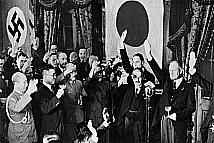
Throughout much of the 1930s, Imperial Japan waged an aggressive war with China, one opposed by the United States. By 1940, with much of Europe overrun by Hitler’s armies, conservative elements in the Japanese government argued that the time was right to overrun Europe’s colonial presence in Asia and use the region’s resources to bring the war with China to a successful conclusion.
Yet in spite of its impressive economy, Imperial Japan was starved of natural resources. Its war planners consequently focused on the seizure of the oil rich Dutch East Indies and the establishment of a defensive perimeter within a ring of Pacific islands to blunt an anticipated counterattack by the United States.
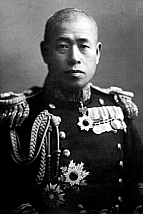
Admiral Isoroku Yamamoto, Commander in Chief of the Combined Fleet, had no illusions regarding war with the United States. He had studied English at Harvard as a young naval officer and even took time off from his studies to hitchhike to Texas. Impressed by the the industrial might of Japan’s potential adversary, he told Japanese Prime Minister Prince Konoye in September, 1941: “In the first six to twelve months of a war with the United States and Great Britain I will run wild and win victory upon victory. But then, if the war continues after that, I have no expectation of success.”
His warnings ignored, Yamamoto threw himself into planning a crippling blow against the United States at the outset of the approaching conflict, and tasked the First Air Fleet with delivering a surprise attack against the main American naval base at Pearl Harbor.
BATTLESHIP ROW
Typically based on the West Coast of California, the U.S. Pacific Fleet was transferred to Pearl Harbor as a deterrent to continued Japanese expansion in Asia. After its move to Oahu, the American battle line was typically moored in the center of Pearl Harbor off the southeastern side of Ford Island, the arrangement eventually named “Battleship Row.” The force included the following battleships:
BATTLESHIP DIVISION ONE: Rear Admiral Isaac C. Kidd*ARIZONA (BB-39): Captain Franklin Van Valkenburgh
NEVADA (BB-36): Captain Francis W. Scanland
OKLAHOMA (BB-37):CaptainEdwardJ.Foy
BATTLESHIP DIVISION TWO: Rear Admiral David W. Bagley
*TENNESSEE (BB-43): Captain Charles E. Reordan
PENNSYLVANIA (BB-38): Captain Charles M. Cooke, Jr.
CALIFORNIA (BB-44): Captain Joel W. Bunkley
BATTLESHIP DIVISION FOUR: Rear Admiral Walter S. Anderson
*WEST VIRGINIA (BB-48): Captain Mervyn S. Bennion
MARYLAND (BB-46): Captain Ernest W. McKee
**COLORADO (BB-45): Captain Leo E. Lindsay
*Division flagship
**USS Colorado departed Oahu for Puget Sound Navy Yard to undergo extensive overhaul on June 25th and was therefore not present during the Japanese attack.
USS ARIZONA: BB-39
The second of the U.S. Navy’s Pennsylvania Class, Arizona was launched in 1915. With a length of 608 feet, it was, at the time, the largest ship in the fleet. Armed with a main battery of twelve 14” guns, Arizona was designed to take its place in the U.S. battle line and engage enemy vessels.
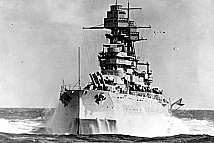
Arizona saw no action during the Great War, spending most of its time protecting the eastern seaboard. It was, however, part of the squadron that escorted President Woodrow Wilson to the Paris Peace Conference in December, 1918. It underwent a major refit from 1929 to 1931, resulting in the installation of new engines, improved armor, and upgraded weaponry before being transferred to the Pacific Fleet, where it spent the rest of its career.
In 1933, Arizona was home ported in San Pedro when the city of Long Beach was struck by a 6.4 earthquake, part of Arizona’s crew going ashore to provide first aid, communications and security for the victims. The following year, Arizona was featured in the James Cagney musical, Here Comes the Navy, which utilized the vessel for interior and exterior location footage. But like most ships, Arizona spent most of its time preparing for war, taking part in annual “Fleet Problem” exercises that simulated engagements with hypothetical enemies, usually at the head of Battleship Division One.
Yet by 1941 a quiet revolution was taking place in naval tactics, centering on the airplane. Already Britain’s Fleet Air Arm had crippled the Italian battleship force in a daring raid on the Italian base at Taranto.
The Imperial Japanese Navy took the lesson, and with war increasingly likely, its aviators began training for a similar attack on the U.S. naval base at Pearl Harbor.
Ship Characteristics:
Type: Pennsylvania Class
Launched: 1915
Length: 608’
Displacement: 37,654 Tons
Main Battery: Twelve 14” Guns
Secondary Battery: Eight 5” Guns
Armor: 18” – 4'
Crew: 1,731
JAPAN'S "FIRST AIR FLEET"
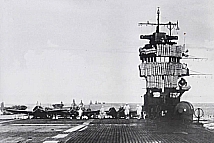
Also known as the Kidō Butai ("Mobile Force"), the First Air Fleet of the Imperial Japanese Navy was formed on April 10, 1941 under the command of Vice Admiral Chūichi Nagumo. With 6 aircraft carriers, 2 battleships, 3 cruisers, and 11 destroyers at the time of Pearl Harbor, the fleet represented the pinnacle of naval aviation. The Kidō Butai included the following aircraft carriers:
CARRIER DIVISION ONE:
AKAGI (RED CASTLE): Captain Hasegawa Kiichi
KAGA (INCREASED JOY): Captain Okada Jisaku
CARRIER DIVISION TWO:
HIRYU (FLYING DRAGON): Captain Yanagimoto Ryusaku
SORYU (GREEN DRAGON): Captain Kaku Tomeo
CARRIER DIVISION FIVE: Rear Admiral Hara Chuichi
SHOKAKU (SOARING CRANE): Captain Jojima Takatsugu
ZUIKAKU (AUSPICIOUS CRANE): Captain Yokokawa Ichibei
BATTLESHIP ROW UNDER ATTACK
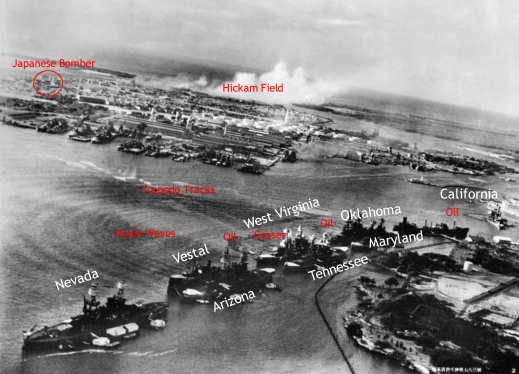
Tasked with destroying the American fleet, the Kidō Butai set sail from Hittokapu Bay in the Kurile Islands on November 26, 1941. Taking position some 230 miles north of Oahu, the First Air Fleet divided their carrier squadrons into two strike groups comprising dive bombers, high level bombers, torpedo bombers, and fighters.
The first wave of 183 aircraft, led by Cmdr. Mitsuo Fuchida, arrived over Pearl Harbor at 7:55 a.m.
Seven battleships were anchored on Battleship Row. Only Pennsylvania was missing, temporarily housed in a dry dock to the south of the primary force. To Fuchida’s disappointment, the American aircraft carriers, a prime target in the Japanese battle plan, were absent. Fuchida ordered the attack, Japanese aircraft striking Kaneohe, Hickam, Ewa, Bellows and Wheeler airfields while the rest of the force attacked American fleet units, the assault lasting until 8:45 a.m.
Japanese losses in this first wave amounted to only 9 aircraft.
The American defenders experienced a short lull before the second wave of 171 IJN aircraft arrived at 8:50 a.m. Now fully alert, American defenses took a toll on the attackers, shooting down 6 fighters and 14 dive bombers before the last Japanese aircraft departed for their carriers just before 10 a.m.
The photograph above, taken by a Japanese observer, shows Battleship Row under attack by low flying torpedo aircraft, the geysers, oil slicks, and torpedo tracks clearly visible. Hickam field burns in the distance after being attacked by dive bombers and strafing fighters.
THE FATAL HIT
Screened from torpedo attack by the USS Vestal, Arizona was the target of Fuchida’s high level bombers.
Although Arizona was hit multiple times, it was a single 1,757 lb bomb, penetrating the deck near the forward turrets, that detonated the supply of black powder required to fire the ship’s 14 inch guns, causing a massive secondary explosion that destroyed Arizona’s bow. Turrets 1 and 2 collapsed into its forward section. The foremast and superstructure, including the bridge also buckled forward, killing Admiral Isaac C. Kidd, commander of Battleship Division One, and Arizona’s skipper, Captain Franklin Van Valkenburgh.
Arizona sank to the muddy bottom of Pearl Harbor in 9 minutes, the fires raging throughout the ship’s remains for two days. A total of 1,177 of Arizona’s complement of 1,512 seamen were killed. Arizona exploding and part of it's sinking was captured on film. See video below from the United States National Archives.
ARIZONA MEMORIAL
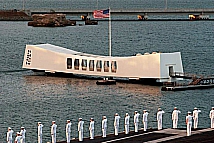
Dedicated in 1962, the USS Arizona Memorial forms part of the Pearl Harbor National Memorial in Hawaii. Although the focus of the memorial is the Arizona, the legislation authorizing construction states that the shipwreck would "be maintained in honor and commemoration of the members of the Armed Forces of the United States who gave their lives to their country during the attack on Pearl Harbor, Hawaii, on December 7, 1941.”
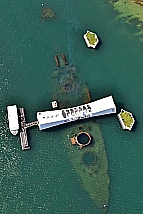
To this day, United States Navy vessels entering Pearl Harbor salute those lost on Arizona when they pass the memorial.
Of particular concern to scientists is the continuing leakage of fuel oil from the Arizona’s bunkers, the sheen of which can be seen at the ship’s stern. Scientists believe the ship retains roughly 500,000 gallons of oil in 20 different fuel bunkers, the “black tears” leaking at a rate of a gallon per day. Removal is possible, but such an effort would most likely destroy the ship and force the removal of the crew’s remains.
Battered by corrosion, Arizona’s hull will eventually collapse, but scientists working with the U.S.S. Arizona Preservation Project believe that the memorialhas another 50 years before any significant action is needed.
THE RELIC
In January, 2020, the United States Navy chose Cal State East Bay to display a relic of the Arizona in recognition of the university’s role in preserving the memory of those lost in the Pacific War.
Originating from the Arizona’s boat deck, the relic will be displayed in the Concord Center main lobby, along with interpretive graphics designed in part by Cal State East Bay students.